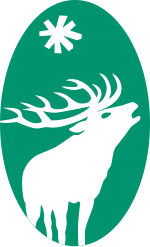Normandy-Maine Regional Nature Park
The Regional Natural Park Normandie-Maine ( fr. Regional Nature Park Normandie-Maine ) is located in the French department Manche and Orne in the region of Normandy and Mayenne and Sarthe in the region Pays de la Loire .
The park extends roughly between the following places:
- Argentan in the north,
- Mamers in the east,
- Évron in the south and
- Mortain-Bocage to the west.
The Perche Regional Nature Park (French: Parc naturel régional du Perche ) connects to the east .
Park management
The nature park was founded on October 23, 1975 and today covers an area of around 257,600 hectares. The park administration with the "Maison du Parc" is based in Carrouges ( 48 ° 33 '48 " N , 0 ° 9' 1" W, ). 138 municipalities (as of January 1, 2018) with a catchment area of around 92,000 inhabitants form the park, another 14 municipalities are associated with the nature park as "access points".
Larger places in the park
In the Orne department
In the Mayenne department
In the Sarthe department
landscape
The nature park in the border area between Normandy and the Pays de la Loire is geologically located in the transition zone of the Armorican Massif and the Paris Basin . This also results in different land forms and land uses . While the western part has a very tranquil, rural character, the eastern part, especially in the area around Alençon - which itself does not belong to the area of the nature park - is more economically used. Characteristic of the huge park area are its bocage , forest and orchard landscapes, crossed by rivers and lakes as well as swamp , heather and raised bog landscapes. Particularly noteworthy are the large contiguous forest areas Forêt des Andaines and Forêt d'Écouves , in the vicinity of which the largest elevations of the nature park are located. In the southern section of the area are the Alpes Mancelles with their stony, wooded steep slopes.
Pear trees are often planted on the orchards of the area , the harvest of which is used in the traditional way to produce pear cider ( French: Poiré ), a special variety of the common apple cider . In Barenton there is the Musée de Poiré , which is specifically dedicated to this topic.
Highest elevations
- Mont des Avaloirs (416 m) ( 48 ° 27 ′ 2 ″ N , 0 ° 8 ′ 40 ″ W )
- Signal d'Écouves (413 m) ( 48 ° 33 ′ 0 ″ N , 0 ° 2 ′ 3 ″ E )
- Butte Chaumont (378 m) ( 48 ° 28 ′ 50 ″ N , 0 ° 1 ′ 37 ″ W )
Larger forest areas
- Forêt de Mortain, east of Mortain
- Forêt des Andaines, near Bagnoles-de-l'Orne
- Forêt d'Écouves, near Fontenai-les-Louvets (today: L'Orée-d'Écouves )
- Forêt de Perseigne, south of Villeneuve-en-Perseigne
- Forêt de Sillé, north of Sillé-le-Guillaume
River valleys
- Catchment area in the upper reaches of the Orne , in the north, with the tributaries
- Sennevière ,
- Thouane ,
- Baize and
- Cance .
- Catchment area in the upper reaches of the Sarthe , in the east and south, with the tributaries
- Catchment area in the upper reaches of the Mayenne , in the center and in the south, with the tributaries
- Catchment area in the upper reaches of the Sélune , in the west, with the tributaries
- Rivière de Saint-Jean and
- Cance .
gallery
Pastures near Champsecret
Waterfall of the Cance near Mortain
Castle of Bagnoles-de-l'Orne
Lake of La Ferrière-aux-Étangs
Fosse Arthour in Saint-Georges-de-Rouelley
Saint-Léonard-des-Bois in the Alpes Mancelles
See also
Web links
- Natural park website (French)




















